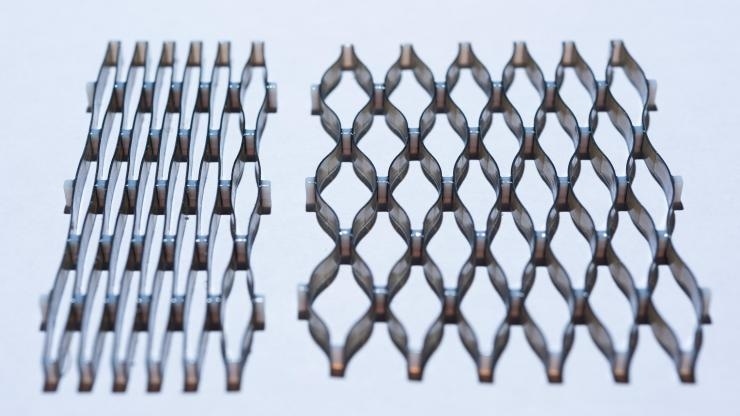Apr 13 2017
 A lattice created by a multi-material 3D printer at Georgia Institute of Technology that can permanently expand to eight times its original width after exposure to heat. Credit: Rob Felt
A lattice created by a multi-material 3D printer at Georgia Institute of Technology that can permanently expand to eight times its original width after exposure to heat. Credit: Rob Felt
Scientists from Georgia Institute of Technology as well as two other institutions have created an innovative 3D printing technique for producing objects with the ability to permanently alter their shape into various different shapes when treated with heat.
To develop the objects, the group including scientists from the Singapore University of Technology and Design (SUTD) and Xi’an Jiaotong University in China printed different layers of shape memory polymers (SMPs), where each layer was patterned to respond in a different manner upon exposure to heat.
This new approach significantly simplifies and increases the potential of 4-D printing by incorporating the mechanical programming post-processing step directly into the 3-D printing process. This allows high-resolution 3-D printed components to be designed by computer simulation, 3-D printed, and then directly and rapidly transformed into new permanent configurations by simply heating.
Professor Jerry Qi, George W. Woodruff School of Mechanical Engineering, Georgia Tech
The study was published in the Science Advances journal (a publication from the American Association for the Advancement of Science) on 12 April. The research was funded by the U.S. Air Force Office of Scientific Research, the U.S. National Science Foundation and the Singapore National Research Foundation through the SUTD DManD Centre.
The creation of the innovative 3D printed objects is a further development of a prior research by the researchers on smart SMP that can recollect one shape and transform into another programmed shape upon exposure to uniform heat, thereby producing objects that can fold themselves along hinges.
The approach can achieve printing time and material savings up to 90 percent, while completely eliminating time-consuming mechanical programming from the design and manufacturing workflow.
Professor Jerry Qi, George W. Woodruff School of Mechanical Engineering, Georgia Tech
In order to exhibit the potential of the new technique, the researchers produced various objects with the ability to expand or bend quickly when they are immersed in hot water. Among the objects was a flower model with petals that could bend similar to a real daisy that responds to sunlight as well as a lattice-shaped object with the ability to expand up to eight times its original size.
Our composite materials at room temperature have one material that is soft but can be programmed to contain internal stress, while the other material is stiff. We use computational simulations to design composite components where the stiff material has a shape and size that prevents the release of the programmed internal stress from the soft material after 3-D printing. Upon heating the stiff material softens and allows the soft material to release its stress and this results in a change—often dramatic—in the product shape.
Zhen Ding, Postdoctoral Researcher, SUTD
According to the research team, the innovative 4D objects can open the door for a wide array of innovative product features, for example, products that can be rolled or stacked flat for being shipped, and can then be expanded for usage. Ultimately, the technology can make way for components with the ability to respond to stimuli such as moisture, temperature, or light in an accurately timed manner to produce space structures, toys, deployable medical devices, robots, and a wide array of other structures.
“The key advance of this work is a 4-D printing method that is dramatically simplified and allows the creation of high-resolution complex 3-D reprogrammable products,” stated Martin L. Dunn, who is the director of the SUTD Digital Manufacturing and Design Centre as well as a professor at SUTD. “It promises to enable myriad applications across biomedical devices, 3-D electronics, and consumer products. It even opens the door to a new paradigm in product design, where components are designed from the onset to inhabit multiple configurations during service.”
The Air Force Office of Scientific Research supported this research initiative under grant 15RT0885, the National Science Foundation under awards CMMI-1462894, CMMI-1462895, and EFRI-1435452, and the SUTD Digital Manufacturing and Design Centre, supported by the Singapore National Research Foundation.
3D Printed Objects Transform with Heat